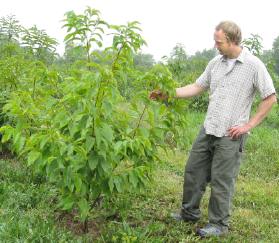 Introduction of a new hybrid of the American chestnut tree would not only bring back the all-but-extinct species, but also put a dent in the amount of carbon in the Earth’s atmosphere, says a Purdue University study.
Introduction of a new hybrid of the American chestnut tree would not only bring back the all-but-extinct species, but also put a dent in the amount of carbon in the Earth’s atmosphere, says a Purdue University study.
Douglass Jacobs, an associate professor of forestry and natural resources, found that American chestnuts grow much faster and larger than other hardwood species, allowing them to sequester more carbon than other trees over the same period. And since American chestnut trees are more often used for high-quality hardwood products such as furniture, they hold the carbon longer than wood used for paper or other low-grade materials.
“Maintaining or increasing forest cover has been identified as an important way to slow climate change,” said Jacobs, whose paper was published in the June issue of the journal Forest Ecology and Management. “The American chestnut is an incredibly fast-growing tree. Generally the faster a tree grows, the more carbon it is able to sequester. And when these trees are harvested and processed, the carbon can be stored in the hardwood products for decades, maybe longer.”
When the Europeans arrived in North America every fourth tree in the Eastern deciduous forest was an American Chestnut (Castanea dentata). They were massive: up to 100 feet tall with a trunk diameter of 5 to 7 feet. In what has been called the world’s greatest botanical disaster, an Asian blight fungus brought to New York in 1904 wiped out this majestic species — billions of trees in only 40 years. . .
Blight-resistant trees have been introduced in Virginia and elsewhere with great success over the last 20 years.
The Purdue efforts have now produced a hybrid that is a cross between blight-resistant Chinese chestnuts and American chestnuts. The resulting species contains about 94 percent American chestnut with the protection found in the Chinese species. Jacobs said those new trees could be ready to plant in the next decade, either in existing forests or former agricultural fields that are being returned to forested land.
“We’re really quite close to having a blight-resistant hybrid that can be reintroduced into eastern forests,” Jacobs said. “But because American chestnut has been absent from our forests for so long now, we really don’t know much about the species at all.”
Jacobs studied four sites in southwestern Wisconsin that were unaffected by the blight because they are so far from the tree’s natural range. He compared the American chestnut directly against black walnut and northern red oak at several different ages, and also cross-referenced his results to other studies using quaking aspen, red pine and white pine in the same region.
In each case the American chestnut grew faster, having as much as three times more aboveground biomass than other species at the same point of development. American chestnut also sequestered more carbon than all the others.
Jacobs said trees absorb about one-sixth of the carbon emitted globally each year. Increasing the amount that can be absorbed annually could make a considerable difference in slowing climate change, he said.
“This is not the only answer,” Jacobs said. “We need to rely less on fossil fuels and develop alternate forms of energy, but increasing the number of American chestnuts, which store more carbon, can help slow the release of carbon into the atmosphere.”
Click to read related Good News Network stories
Chestnut Tree Poised for Comeback
Chestnut Tree Discovered Growing
Virginia Group Grows Blight-Resistant Trees



















